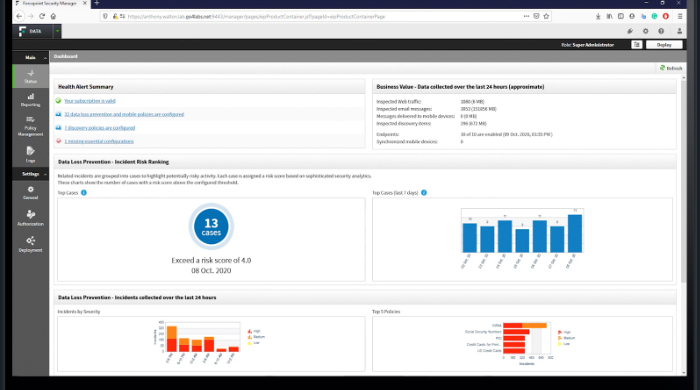Forcepoint is scaling up to 8X the data visibility capabilities that were previously possible to enable enterprises manage their data growth. The company has already been at the forefront in simplifying visibility with over 1,500 pre-built out-of-the-box templates that made it much easier to quickly deploy and efficiently manage DLP. Additional scalability brings needed power to these capabilities to easily manage much larger, unwieldy data sets.
Organizations strive to identify data loss as it happens. But what if it was possible to identify data loss before it happens? That’s the idea behind something we call Risk-Adaptive Protection (RAP). On average, it takes organizations 287 days to clearly identify and then contain a data breach. RAP utilizes over 150 “incidents of behavior” (IoBs) to continuously monitor users for risky behavior. It brings true zero-trust capabilities to DLP while delivering context, automation, and precision to DLP policy enforcement.
In the same way that Forcepoint DLP (DLP Everywhere) covers all the main vectors of security or channels (endpoint, web, cloud applications, cloud web and cloud email) RAP will soon cover not only the endpoint but also cloud web, cloud email, cloud applications and removable storage.
As one Forcepoint RAP customer stated, she finds the capability “… incredibly exciting by virtue of the fact that we can start to be much more targeted in our security.”
The amounts of data that organizations create, ingest and very often lose track of has been growing exponentially for many years. That aggressive data growth shows no signs of slowing in the future. It’s estimated that by 2025, there will be 181 zettabytes of data globally. It’s hard to get our minds wrapped around how much data that is but if you just look at the number (181,000,000,000,000,000,000,000 bytes) it already looks huge. Put another way, if each grain of sand equaled one byte, then there would be around 7.5 exabytes of sand on the earth [1024 exabytes = 1 petabyte and 1024 petabytes = 1 zettabyte].
Data can be a tremendous resource—but organizations require visibility and control of all of that data. For organizations, that means going beyond knowing what data you have, to understand who’s using it, how it’s being used and where it’s being used from.
Getting a handle on dark data
For many companies, the ability to collect data far exceeds their ability to derive any use from it. In most cases the majority of data collected becomes dark data. Dark data is data organizations possess that remains unused. In other words, dark data is not being used to gain insights or make informed decisions. Why not just delete all this extra data? One reason of course is data is valuable – “the new oil.” Many companies don’t simply delete dark data because a lot of it contains sensitive information which needs to be retained for compliance purposes. Due to compliance regulations, organizations are held responsible for all the data they acquire.
Forcepoint’s new DLP capabilities help organizations shed light on dark data. Combining this scale with Forcepoint DLP capabilities enables customers to solve their dark data issues on two fronts. The first front is by dramatically increasing the amount of data that can be processed. Secondly, it has made it faster too. As an example, Forcepoint DLP simplifies things like compliance audits with its ability to handle up to 8X more data at 15X the speed.
With out-of-the-box policies covering 86 countries and over 155 regions we can help customers with the most challenging regulations to successfully account for all the data they have at remarkable speed. With Exact Data Match (EDM), Forcepoint DLP now allows customers to fingerprint 5X more data (up to 100 million records or 600 million fields) to give them incredible visibility and control across their data.
“We’ve fingerprinted almost 20+ million files with Forcepoint DLP and look forward to scaling that up to 100 million files in the near future,” said Elif Ahmetoglu, Information Security Manager, VakifBank.
Forcepoint DLP is also now able to retain 8x more incidents for forensics purposes.
Bringing visibility and control to removable storage
To round things out, Forcepoint is also announcing new device control capabilities. Forcepoint DLP already had ways of controlling data exfiltration to USB drives. Now, they’re adding important capabilities that allow for much stronger control of these ubiquitous storage devices that are regularly being plugged into endpoints. Data security admins can see exactly what removable storage device is being plugged in, what data is going into those devices, what data is coming into the organization from those devices and be able to apply simple controls such as allowing, read-only, and blocking.
Read More News: https://www.smechannels.com/category/news/ || Watch CIOtv: https://ciotv.live/ || Read IT Leaders News: https://www.enterpriseitworld.com



